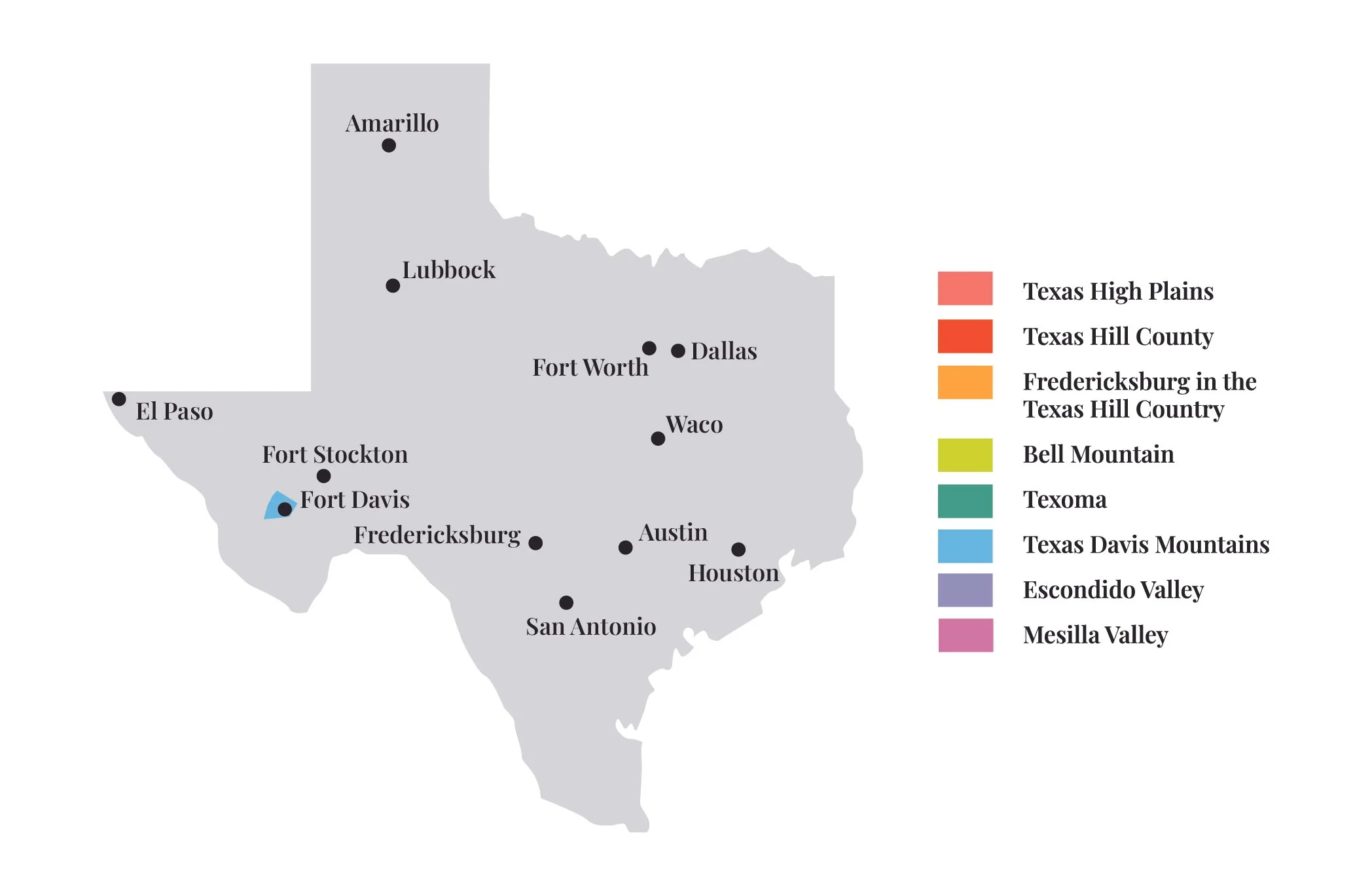Texas Davis Mountains AVA:
Volcano‑Forged Vines at Texas’s Roofline
Approved in 1998, the Texas Davis Mountains American Viticultural Area (AVA) crowns the highest wine‑growing terrain in the Lone Star State. Centered around the volcanic Davis Mountains in Jeff Davis County, the AVA covers about 270,000 acres between 4,500 and 6,200 feet—altitudes that rival Argentina’s Uco Valley and Colorado’s Grand Valley. For beginners, this remote, rugged outpost teaches how elevation, ancient lava flows, and high‑desert conditions combine to craft cool‑climate flavor in the heart of West Texas.
Location & Landscape
The AVA lies roughly 20 miles northwest of the artist enclave of Marfa, encompassing the towns of Fort Davis and Valentine. Shield volcanoes and igneous intrusions form saw‑tooth peaks that funnel cool air into valley vineyards each night. Soils are volcanic—rhyolitic tuff, basalt, and granite—carpeted by thin, rocky loams and peppered with agave and piñon pine. Steep slopes (10‑25 percent) promote drainage and maximize sun exposure, but mechanization is limited; most work is done by hand.
Climate: Alpine Days, Desert Nights
· Rainfall: 16–20 inches annually—highest in West Texas—delivered mainly in July–September monsoon bursts.
· Temperature: Summer highs hover in the mid‑80s °F, while nights plunge into the mid‑50s °F, producing a 30 °F diurnal swing even in August.
· UV Intensity: Thin mountain air (5,000 ft) boosts ultraviolet exposure, thickening grape skins and deepening color.
· Wind: Mountain breezes averaging 15 mph keep mildew at bay but require windbreaks for young vines.
Key lesson: Elevation flips the Texas stereotype—instead of battling scorching nights, growers here fight late spring freezes and hail common above 5,000 feet.
Terroir: Volcanic Rocks & Thin Mountain Loams
Eroded lava flows from 35‑million‑year‑old volcanic blasts left layers of rhyolite, andesite, and basalt. These rocks crumble into mineral‑rich, fast‑draining loams that force deep rooting and impart a subtle iron and graphite note—most evident in Bordeaux and Rhône reds. High stone content stores heat, easing the chill after sundown and extending the ripening window.
Signature Grapes & Why They Thrive
Cabernet Sauvignon - Cool nights preserve acidity; volcanic soils add graphite and cassis depth.
Merlot - Ripens fully at 5,000 ft yet retains plum freshness—a rarity in Texas.
Grenache - Thrives on rocky slopes; high UV elevates strawberry and white‑pepper notes.
Syrah - Northern‑Rhône analog: warm sun, cool nights, granitic sub‑soils—yields bacon‑fat & violet aromatics.
Sauvignon Blanc - High altitude locks in citrus zip; diurnal swing prevents tropical overripeness.
Riesling - Experimental but promising—late budbreak avoids spring frost, cool fall nights preserve lime‑peel zing.
Plantings are limited (< 150 acres), but the AVA’s altitude encourages wineries to test classic cool‑climate varieties uncommon elsewhere in Texas.
Interesting Facts
· Star‑Gazing Vineyards: Home to McDonald Observatory, the region’s dark skies rival Chile’s Elqui Valley—perfect for night harvest under the Milky Way.
· Pioneering Vineyard: Blue Mountain Vineyard’s Cabernet Sauvignon and Sauvignon Blanc (planted 1970s) proved high‑altitude potential decades before AVA status.
· Wildlife Friendly: Vine rows share habitat with black bears, javelina, and migratory raptors—growers erect hawk perches for natural rodent control.
· Lowest Temperatures in Texas: Winter lows can hit 0 °F—not your typical Texas heat—so cold‑hardy rootstocks are a must.
Visiting & Nearby Cities
• Fort Davis – 5 miles to most vineyards; historic frontier fort and scenic loop drives
• Marfa – 25 miles south; art installations and boutique hotels
• Alpine – 25 miles southeast; Sul Ross State University and craft breweries
• El Paso – 190 miles west; major airport
Tasting rooms are scarce—appointments only—but visitors can pair wine tours with star parties at McDonald Observatory and hikes in Davis Mountains State Park.
Putting It All Together
Texas Davis Mountains AVA shatters the ‘all Texas wine is hot‑climate wine’ myth. Here, elevation and volcanic soils mimic the conditions of Alpine Europe or the Andes, producing reds with tension and whites with electric acidity. Study this AVA to see how altitude can override latitude.
· Volcanic + altitude = mineral drive—taste a Davis Mountains Cabernet beside a Lower Valley Cabernet to note graphite versus jam balance.
· Late frosts challenge vineyard management—prune late, favor late‑budbreak varieties, and deploy wind machines.
Next time you savor a Davis Mountains Syrah laced with violet, bacon fat, and mountain sage, picture the ancient lava flows and cool desert stars sculpting each sip.

